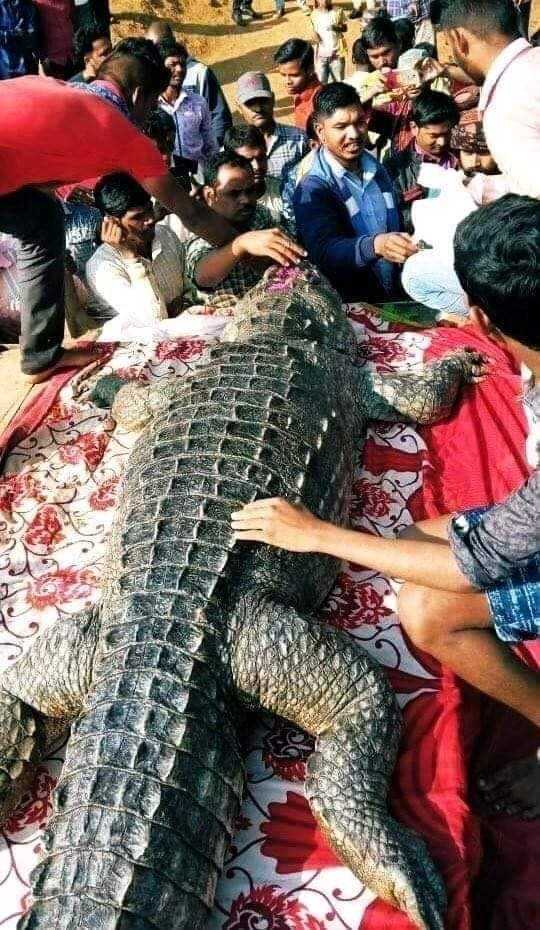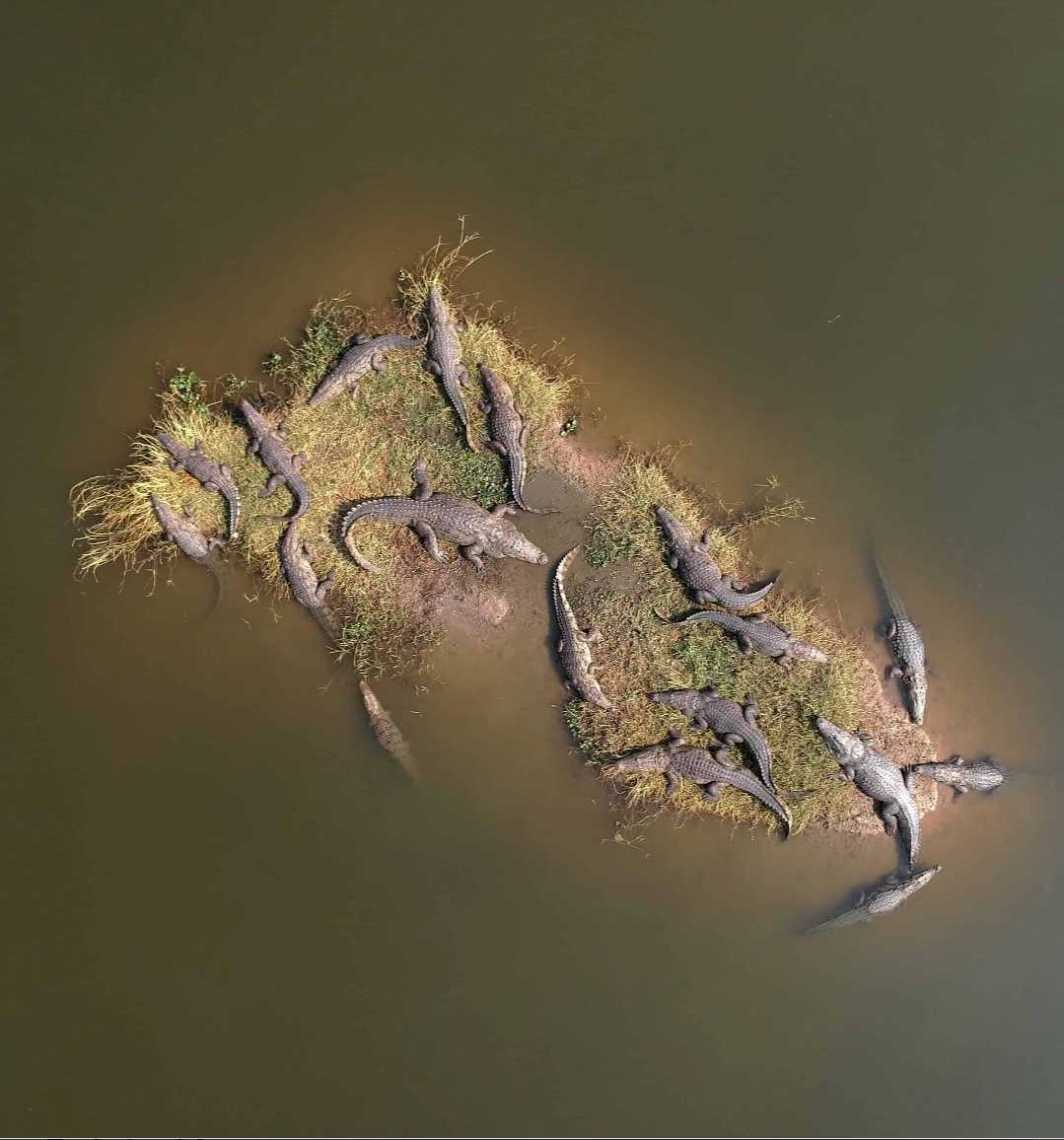Why a 130-YO Crocodile Named Gangaram Has a Memorial Dedicated to Him
Chhattisgarh's Bawa Mohtara village is home to a unique memorial dedicated to a beloved old crocodile, Gangaram. His endearing story is beacon of hope for human-wild animal coexistence.

“He was not a crocodile but a friend,” Basawan, a resident of Bawa Mohtara village in Chhattisgarh’s Bemetara district, told Hindustan Times after the death of the 130-year-old Gangaram in 2019.
Crocodiles are widely feared, but not in Bawa Mohtara. This is because, for the longest time, this tiny village was home to Gangaram, one of the most docile members of this dangerous predator species.
Loved and revered by his village, Gangaram would swim peacefully alongside young children while their mothers washed clothes on the banks of his pond. No one was ever attacked by him, and the villagers responded with respect, ensuring that the croc was never harmed.
In short, he broke the mould of ‘vicious crocodile’ and his fellow villagers broke the ‘cruel human’ one.
Bawa Mohtara was known as the ‘Magarmachha-vala gaon’, because of Gangaram’s peaceful presence in the village pond. So when he passed away of natural causes after a long life, the entire village assembled to grieve and bid an emotional adieu to their beloved crocodile.
He was carried to its funeral on a tractor decorated with garlands, with over 500 people attending its last rites. Many of the grief-stricken villagers also didn’t cook food that day. In the years that followed, the residents of Bawa Mohtara set up a memorial in Gangaram’s honour on the pond’s bank.

Interestingly, Bawa Mohtara isn’t the only village in India to witness such a peaceful coexistence between predators and humans.
In Gujarat’s Charotar district, humans and crocodiles go about their business without attacking or even disturbing each other. According to surveys by the local NGO, Voluntary Nature Conservancy, there are at least 164 resident mugger crocodiles in Charotar’s 30 villages, an area that packs over 600 people per sq km.
Almost every pond in these villages is abuzz with crocodile activity but this doesn’t deter the residents from swimming in them, washing their cattle and clothes, and harvesting water chestnuts. The reptiles, meanwhile, raise their young on the same banks, basking in the sun and crawling through the grass where cattle graze and children play.
Yes, there are the occasional attacks but they are way lesser than the norm. So much so, that the residents of Charotar not only make excuses for these rare attacks, they also plan to dig extra ponds to give the crocs more space!

Little wonder the wetlands of Charotar have proven to be the safest haven for the giant reptile species in Gujarat. Talking of safe havens for reptiles, this story would be incomplete without a nod to Shetpal, the unique village in Maharashtra’s Solapur district where snakes are considered family.
In Shetpal, it is a normal occurrence to see snakes slither around people’s homes and even through school classrooms. In fact, each house in the village, no matter how tiny, keeps aside a hollow space known as ‘devasthanam’ (abode of the deity) where snakes can rest and cool off at any time.
Bawa Mohatra, Charotar and Shetpal are all just beautiful examples of humans and wild reptiles co-adapting to living in shared landscapes.
But human-wildlife coexistence is more than a conservation concern, it is just as much a humanitarian and development concern. By avoiding persecuting the wildlife living around our habitats, we humans safeguard the health of our ecosystem, and therefore our own well-being and future food security.
In fact, one in five of all reptile species in the world are threatened by extinction, which could be a ‘devastating’ blow to the planet’s biodiversity, according to a study by Nature.
“If we remove reptiles, it could change ecosystems radically, with unfortunate knock-on effects, such as increases in pests and insects. Biodiversity, including reptiles, underpins the ecosystem services that provide a healthy environment for people,” Neil Cox, co-leader of the aforementioned study at the International Union for Conservation of Nature (IUCN), told the Guardian.
So, at a time when human-reptile conflict is often in the news, Gangaram’s endearing story comes across as a beacon of hope. One can also hope that there are more Gangarams out there, waiting to be discovered, loved and protected by humans.
Sources
500 people attend last rites of beloved 130-years-old crocodile in Chhattisgarh village by Ritesh Mishra, Published on 10 January 2019.
The Indians sharing their villages with crocodiles by Anirudh Vasava, Published on 31 January 2019.
A global reptile assessment highlights shared conservation needs of tetrapods by Nature, Published on 27 April 2022.
One in five reptiles faces extinction in what would be a ‘devastating’ blow by The Guardian, Published on 19 May 2022.
Edited by Yoshita Rao
If you found our stories insightful, informative, or even just enjoyable, we invite you to consider making a voluntary payment to support the work we do at The Better India. Your contribution helps us continue producing quality content that educates, inspires, and drives positive change.
Choose one of the payment options below for your contribution-
By paying for the stories you value, you directly contribute to sustaining our efforts focused on making a difference in the world. Together, let’s ensure that impactful stories continue to be told and shared, enriching lives and communities alike.
Thank you for your support. Here are some frequently asked questions you might find helpful to know why you are contributing?


This story made me
-
97
-
121
-
89
-
167











